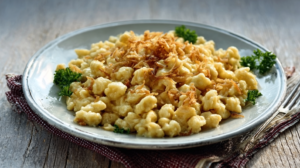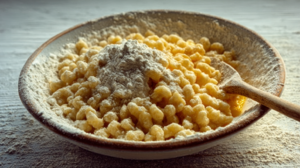Spaetzle (or Spätzle) are a treasured part of German culinary heritage—soft, chewy egg noodles with roots in the Swabian region of southern Germany. Often served alongside rich gravies, melted cheeses, or simply tossed in butter, Spaetzle are a comfort food that has stood the test of time. Whether you’re revisiting family traditions or exploring new tastes, this step-by-step guide will help you make the perfect homemade Spaetzle, just like the ones cherished across Baden-Württemberg.
Table of Contents
What is Spaetzle?
Spaetzle, pronounced “shpets-luh,” are small, irregularly shaped noodles made from flour, eggs, and milk or water. Hailing from the Swabia region—also known as Schwabenland—these soft egg noodles are a staple in German households and are also popular in Austria and Switzerland. The word “Spätzle” translates to “little sparrows,” a nod to their shape when cut by hand.

From cheese-laden casseroles like Käsespätzle to hearty side dishes, Spaetzle are incredibly versatile and deeply rooted in Central European tradition.
Ingredients for Homemade Spaetzle
Making Spaetzle from scratch requires only a few basic ingredients:
-
2 cups all-purpose flour (can substitute with whole wheat)
-
4 large eggs
-
1/2 cup milk or water (milk adds extra richness)
-
1½ teaspoons salt
-
1/8 teaspoon freshly ground nutmeg (optional)
Optional for serving:
-
Melted butter or oil
-
Fresh parsley or crispy onions
How to Make Spaetzle Dough
Traditionally, Spaetzle dough was made by hand using a spoon and a lot of elbow grease. Today, you can speed up the process using a stand mixer.
Step-by-Step Dough Instructions
-
Combine dry ingredients:
In the bowl of a stand mixer, add the flour, salt, and nutmeg (if using). Stir well. -
Whisk eggs:
In a separate bowl, whisk the eggs until fully beaten. -
Form the dough:
Make a well in the center of the flour mixture and pour in the eggs. Add the milk or water. -
Mix the dough:
Use the paddle attachment and mix on a low setting (speed 2) for about 10 minutes. You’re aiming for a thick, elastic batter—not too runny and not too stiff.

How to Tell When the Dough is Ready
The batter is ready when small bubble holes form after stretching the dough with a spoon. If you don’t see these bubbles, continue mixing for a few more minutes.
Choosing the Right Spaetzle Maker
There are several ways to form Spaetzle noodles:
-
Spätzle Press – Like a potato ricer, this tool pushes the dough through holes directly into boiling water. Brands like Kull and Westmark are highly recommended.
-
Spätzle Board (Spätzlebrett) – A wooden board and knife traditionally used to hand-cut Spaetzle into simmering water.
-
Spätzle Scraper or Plane – A metal lid or grater with large holes; simply push dough through using a scraper.
Cooking the Spaetzle
-
Boil water:
Bring a large pot of lightly salted water to a boil, then reduce to a simmer. -
Press the dough:
Using your chosen Spaetzle maker, push the batter into the simmering water. The noodles will sink, then rise to the surface when done (about 2–3 minutes). -
Cool immediately:
Scoop the Spaetzle out with a slotted spoon and place them into a bowl of ice water. This helps them firm up and keeps them from sticking together. -
Drain & toss:
Drain well and toss with a bit of butter or oil.
Storage Tips & Freezing Instructions
Spaetzle is perfect for meal prep and leftovers.
-
Refrigerator: Store in an airtight container for up to 4 days.
-
Freezer: Place cooled noodles in a freezer-safe container or bag and freeze for up to 3 months.
Reheating Suggestions
-
Skillet method: Sauté Spaetzle in melted butter until heated through.
-
Microwave: Reheat in a covered container to retain moisture.
What to Serve with Spaetzle
Spaetzle pairs beautifully with many dishes. Here are some popular options:
Traditional Ways to Serve:
-
Buttered Spaetzle: Toss with melted butter and garnish with parsley.
-
Käsespätzle: Layer Spaetzle with grated cheese and crispy onions.
-
With Sauces/Gravies: Pairs well with onion gravy, mushroom gravy, or creamy sauces.
-
With Meats: Serve with schnitzel, sauerbraten, goulash, pork roast, rouladen, or bratwurst.
-
In Soups: Add Spaetzle to hearty soups like German pea soup or Gaisburger Marsch.
-
Cold Pasta Salads: Combine with vinaigrette, cheese, herbs, and diced meats.
Expert Tips for the Best Spaetzle
-
Thicker is better: A slightly thicker batter gives a chewy, authentic texture.
-
Use cold water bath: Firm up cooked Spaetzle instantly for better texture.
-
Don’t overboil: Simmering gently helps prevent mushy noodles.
-
Reheat with butter: Always warm leftovers in butter for best flavor and mouthfeel.
Nutrition Facts (Per Serving)
| Calories | Carbs | Protein | Fat | Fiber |
|---|---|---|---|---|
| 345 | 63g | 12g | 3g | 2g |
Contains: Egg, Gluten
May vary depending on specific ingredients used.
Final Thoughts
Spaetzle is more than just a noodle—it’s a tradition, a comfort food, and a showcase of German culinary excellence. Whether you’re new to making homemade pasta or grew up eating it, this Spaetzle recipe delivers authentic taste and texture. Give it a try with butter, cheese, or gravy and enjoy a taste of Swabia from your own kitchen.
Guten Appetit!

